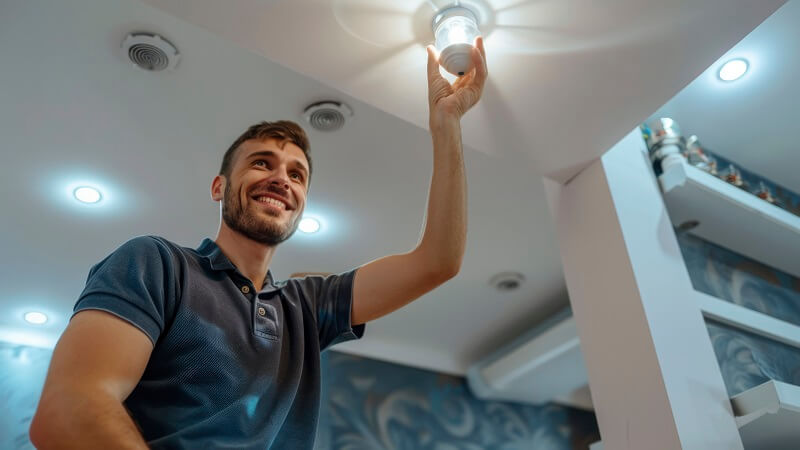Bathrooms and other wet places can be very dangerous when smart lights are incorrectly set up. Water, steam, and electricity don’t mix well. If we’re not careful, this mix can cause problems like broken wires, electric shocks, or even fires. We must be careful when putting smart lights in these wet areas.
To minimize these risks, it’s crucial to use strategies such as correctly rated fixtures, proper insulation, and following safety standards. These rules help make safe lighting for residential spaces, especially where there’s water.
If you don’t know which areas count as wet, which lights to choose, or how to put them in safely, don’t worry. Let’s discuss these important things in detail.
Understanding Wet Area Classifications
Let’s learn about different wet bathroom areas to learn their classification. Bathrooms are typically divided into zones based on their proximity to water sources:
- Zone 0: Inside the bathtub or shower
- Zone 1: The area directly above the bathtub or shower, up to a height of 2.25 meters
- Zone 2: The area extending 0.6 meters outside Zone 1, and to a height of 2.25 meters
- Outside zones: Any area outside the above zones
Each zone has specific requirements for electrical fixtures, including lighting. Pay attention to IP (Ingress Protection) ratings, which indicate a fixture’s resistance to water and dust. Look for fixtures with high IP ratings for wet areas, such as IP44 or higher.
Choosing the Right Smart Lighting for Wet Areas
Choosing the right smart lights for bathrooms means thinking about how they work and how safe they are. Pick bulbs that can handle dampness and lights that won’t let water in. Look for features like:
- Humidity sensors to adjust lighting based on moisture levels
- Anti-fogging capabilities for mirrors
- Dimming options for creating the right ambiance
- Color temperature adjustments to match the time of day or your preferences
Consider Correct IP Ratings
IP (Ingress Protection) ratings are essential when selecting lighting fixtures for wet areas. The IP rating consists of two digits:
- The first digit (0-6) indicates protection against solid objects
- The second digit (0-8) indicates protection against liquids
For bathrooms and wet areas, look for fixtures with a minimum rating of IP44, which provides protection against water splashes from all directions.
Smart Bulbs vs. Smart Switches
When it comes to smart lighting, you have two main options:
- Smart bulbs: These can be controlled remotely but may not be suitable for all wet area fixtures.
- Smart switches: These control traditional bulbs and are often a safer choice for wet environments.

Safety Precautions Before Installation
Before you start putting in lights, do these important safety things:
- Turn off the power at the main box to stop any chance of getting shocked.
- Look around for wet spots or fuzzy stuff on walls. Fix these before you start.
- Ensure you have the right tools and safety, like special gloves and eye covers.
Installation Best Practices for Smart Lighting in Wet Areas
Installing smart lights in wet places requires extra care to keep everyone safe. Here are some important things to do when installing smart lights in bathrooms or other damp areas.
Hiring a Professional
While some DIY projects are easy for some people, installing lights in wet places can be tricky. It’s better to ask an expert who knows about electricity.
Proper Sealing and Waterproofing
All lights and boxes where wires meet in wet places need to be closed up tight. This stops water from getting in. Use special rubber rings and sticky stuff that keep water out where needed.
GFCI Protection
Special outlets with Ground Fault Circuit Interrupters (GFCIs) are very important in wet places. These devices quickly turn off the power if something’s wrong, making it much less likely that electricity will shock someone.
Smart Lighting Features for Wet Areas
Smart lights can improve and protect wet areas like bathrooms. Some of their smart features working well in damp places include:
Motion Sensors
Installing motion-activated lighting in bathrooms can be the right option. They work without touching and save power.
Dimming Capabilities
Dimmable smart lights are good for baths and conserve energy. When installing dimmer switches, use ones made for wet places.
Color Temperature Adjustment
Some smart lights let you change how warm or cool the light looks. Cooler light can help you wake up in the morning. Warmer light is nice for relaxing at night.
Things to Think About for Recessed Lighting
Many people like hidden lights in bathrooms because they look nice and spread light evenly. When putting these lights in wet areas, think about these recessed lighting safety tips:
- Use lights made for wet places
- Put in good coverings to stop water drops from forming
- Add special layers to keep wetness away
- Use IC-rated lights if they touch the fluffy stuff on the walls
Maintenance and Upkeep
Checking and fixing your smart lights in wet areas is very important. It helps them last longer and stay safe. Here are some ideas:
- Often, look for wet spots or rust on your lights
- Clean lights according to manufacturer instructions
- Check GFCI outlets every month
- Update the smart device’s firmware to keep it working well and safe
- Keep the room airy to stop wetness from building up, which can hurt electric parts over time
Conclusion
Putting smart lights in bathrooms requires careful thinking about safety and rules. Choose good lights, install them right, and take care of them. If unsure, ask an expert. Don’t forget recessed lighting safety tips for hidden lights. With smart lights, your bathroom can be safe, pretty, and work well. This makes your daily life better and your home nicer.
For more tips and advice, visit DesignMode24.
